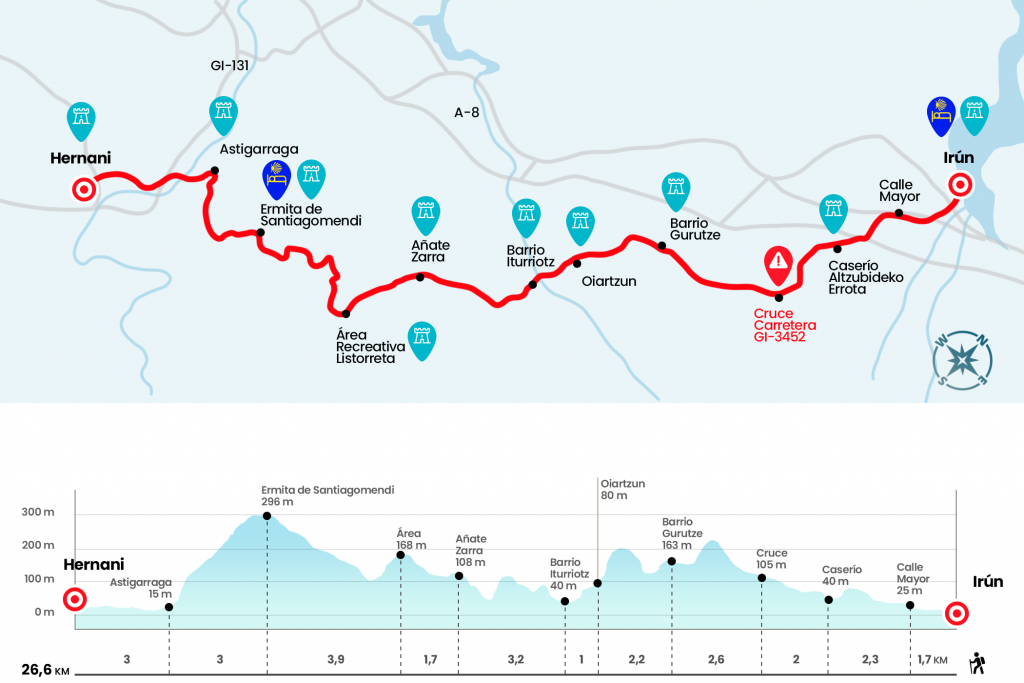Article translated by an automatic translation system. Press here for further information.
Irun to Hernani Phase
Official start of the road on the Puente de Santiago, border with France
Information about the stage 1: Irun to Hernani Phase

Enlarge map
Points of interest in the stage 1: Irun to Hernani Phase
The route
Whether it is our intention to start the Camino del Norte in pursuit of the encounter with the Cantabrian coast or to undertake the solitary and still little known Camino del Interior, as is our case, tradition demands to start the steps on the border bridge of Santiago that saves the estuary of the Bidasoa River. On the first roundabout, you have to turn left and go towards the Real Union stroll that advances along the river, in an almost maritime landscape populated by seagulls, small boats - some of them reduced to their skeleton - and early sailors. We leave this nice company to access the neighborhood of Santiago, area covered by the waters until the 19th century that leads us to the church of Nuestra Señora del Juncal, gothic, three naves and baroque front that keeps a precious size of the Virgin. We surround the church and from the plazoleta of the Juncal we climb the stairs of Eskoleta Street, passing by a bronze figure representing a cantinera of the San Marcial smear. Then we turn left to cross the Paseo de Colón, next to the palace of Arbelaiz, and head towards the town hall of Irún. Leaving its facade to the left we access Calle Mayor (karrika Nagusia in Euskera), and in the first bocacalle to the right we find the diversion to the Camino de la Costa or del Norte (km 1.7).
We ignore it, we rise in front of Calle Mayor and after a walk of pedestrians we move next to the nice building of the municipal library and later next to the sports club, point in the turn left in slight descent. In a sea of signs, traffic lights and buildings it is very easy to miss and we must continue along Elizatxo Avenue towards the Ventas district. Thanks to a timely yellow arrow painted on a Jacobean cairn, similar to those that abound in Galicia, we turn left to cross the avenue and continue down the ascending street Belitz (Km 2,6). This leads us to move on the A-8 highway, an expected moment that puts an end to the tedious urban core and that gives way to a smoother section of meadows and farmhouses. After climbing 150 meters per paved runway, we turn to the right for another concrete, opening before us a scene where the A-8 separates the rural way of life from the urban, the villages of the industrial sites and the labors in factories. Two opposite realities that many have long had to share to survive. Thus we reach a junction where a wooden sign from the Basque Government (with the inscription Donejakue Bidea / Camino de Santiago) marks us 6.9 kilometers to Oiartzun. We continue on the left and immediately pass by the farmhouse Altzubideko Errota (Km 4).
We walk away on a path that follows the course of the Urdiñegiko race and that goes along with native and American robles and chestnuts. The path leads us to cross the regatta (Km 5.1) to return to the road and reach a meadow that we walk along the fence. After a ship we continue briefly on the runway to the road GI-3452 (Km 6), which gives us its insignificant arcén for a mere five hundred meters. We left the road to catch a track that leads to a scattered settlement area belonging to the Olaberria neighborhood. He greets us with the characteristic green mailboxes, always located next to the roads of more transit so that the porters do not have to be beaten more from the account. We then went next to a dismantling and followed by the Iturburu, Telleria and Txirripa. After the latter, we can now see Gurutze, the district of the municipality of Oiartzun to which we arrived later (Km 8,6). In Gurutze we continue for 50 meters next to the GI-2131 and leave it on the right to go down a road next to the Pintoko race. At the end of the descent, instead of continuing towards the regatta, we turn left and we start climbing up to a cement track that we will not leave (not following the white and yellow markings of path that enter right through the forest) until we chop and delight with the magnificent view of Oiartzun. We spent the old pilgrim hospital, reconverted into the Manuel Lekuona library, and the gothic church of San Esteban de Lartaun to reach the Plaza del Ayuntamiento (Km 10,8).
We continue on the right, on Manuel Lekuona Street, and we always go straight down (signs are very fair), passing a roundabout to reach the bridge over the Oiartzun River and access the Iturriotz district (Km 11,8). We left the 16th-century Iturriotz tower to the left and fired from the core by a cement court. After several deviations we left the track to enter the tree and cross the Arbide regatta (very attentive to signaling after this step. If we have to turn it off a second time we are not going in the right direction). After the stream we go up a path that leads to a runway, which we then leave to take a path that leads us in turn to another runway through which we go up to a hill. Here a signal marks 10.5 kilometers to Astigarraga. We descend around the oak chestnut and pass by the Sorozarreta farmhouse, which is next to a horseshoe curve. After crossing a stream, we reactivate the lungs before the coming echo. We left a slice aside and turned right to access a runway. Then turn left and move to the rural house Añarre Zarra (Km 15).
We retake the march on the same track for 350 meters and, together with the Oiarzabal dwarf, we take a path that goes indoors between pines and eucalyptus and that we must continue straight relying on the almost null and worn yellow arrows that we will find. We will reach a high voltage tower and then Borda Berri and the recreational area Listorreta, door of the natural park of Peñas de Aia (Km 16,7). From the bar, to see the next dip, you don't have to go straight towards the merendero but move to the parking lot on the right and take the paved runway. Only for a hundred meters to turn right down a road that descends (with very slippery water) to a plain area where we cross a creek to, of course, go back on a road that curves and reaches Fransilla Berri (km 18,3). We go on a road, which we follow on the right and leave immediately on the left, to continue on the left hand (sometimes it costs a lot to see the wooden crabs) on the runway that rises. We are awaiting several crossings and a journey that no longer brings a breath but in its final part, if the day allows, offers us a view of the Cantábrico and the nearby San Sebastián. The route leaves aside the hermitage of Santiagomendi, but we only have to give up a hundred meters to reach it, enjoy the panoramic and breathe relieved at 296 meters altitude, the highest level of the stage (km 20,6).
Well rested, we leave Santiagomendi on the paved runway, here are now two options, follow by asphalt to Astigarraga, this option is recommended for cyclists or days of intense rain, or we turn left to take a path through which we will start the descent that soon becomes a trot surrounded by thorns and with a lot of stones that goes down to a asphalted runway. We take it on the left to turn right at the first junction and get to the Artola steelworks. From here to Astigarraga, shortly under our feet, it is a comfortable walk. The two options are similar in distance and marked. Already in the urban area a sign still allows to deviate towards the Camino de la Costa, but we throw towards Ergobia and Hernani (Km 23,6).
After the Ergobia neighborhood we turn right to cross the bridge over the Urumea River. Then, before the level step, we curve left and we advance flanked by the train tracks and industrial ships. Later on, a turn to the right leads us to an underground step under the tracks (eye with head, only 1.30 in height) that allows us to save them safely. We continue on the left by the road passing through the Florida neighborhood, antesala of Hernán, an end of stage village we enter through Plaza Zinkoene to take Calle Mayor (Kale Nagusia) and reach Plaza Gudarien, where is the City Hall and the church of San Juan Bautista (Km 26,6).
The difficulties
Remarks
In images
The hostels

¿Do you want to send any photo of "The Camino de Santiago"?
If you have any photos of "El Camino de Santiago" that you want to share with us, you can send them to us and enlarge the photo gallery

Forum: What pilgrims think about the Camino de Santiago
See all